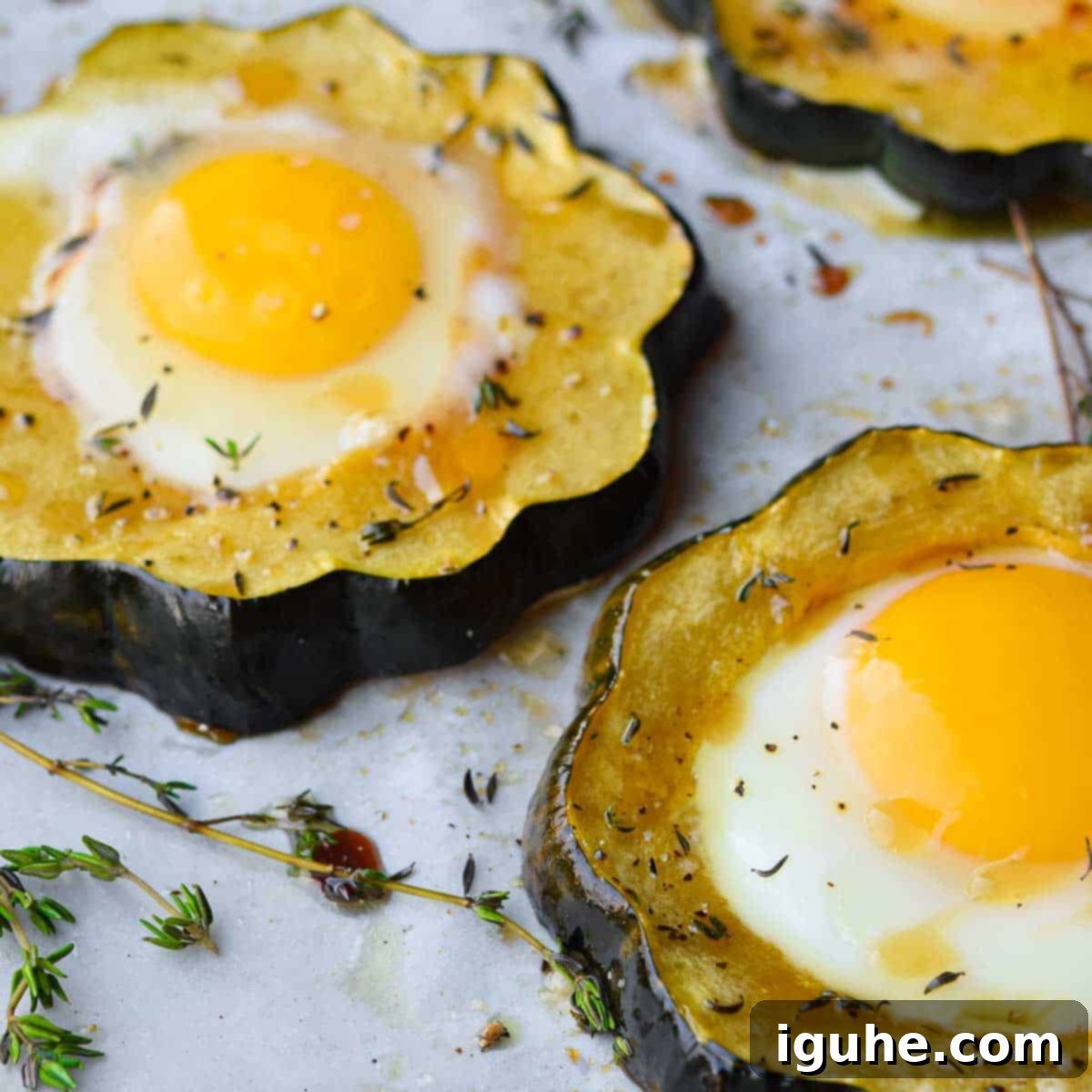Savory & Sweet Acorn Squash Egg in a Hole: The Ultimate Hot Honey Thyme Breakfast Recipe
Forget everything you thought you knew about “egg in a hole.” This innovative Acorn Squash Egg in a Hole with Hot Honey and Thyme redefines breakfast perfection, offering a tender, flavorful, and visually stunning start to your day. Who says the “hole” has to be bread? Here, nature provides the ideal, naturally beautiful vessel: a perfectly roasted acorn squash ring. Each slice of squash is transformed in the oven, caramelizing with a delightful blend of sweet and spicy hot honey and fragrant fresh thyme until it reaches peak tenderness. Then, a fresh egg is gently nestled into the center, cooking to create a charming, flower-like appearance that’s as pleasing to the eye as it is to the palate. This dish is an irresistible combination of tender, sweet, and vibrantly flavored ingredients, making it the egg breakfast you never knew you needed, but won’t be able to live without.
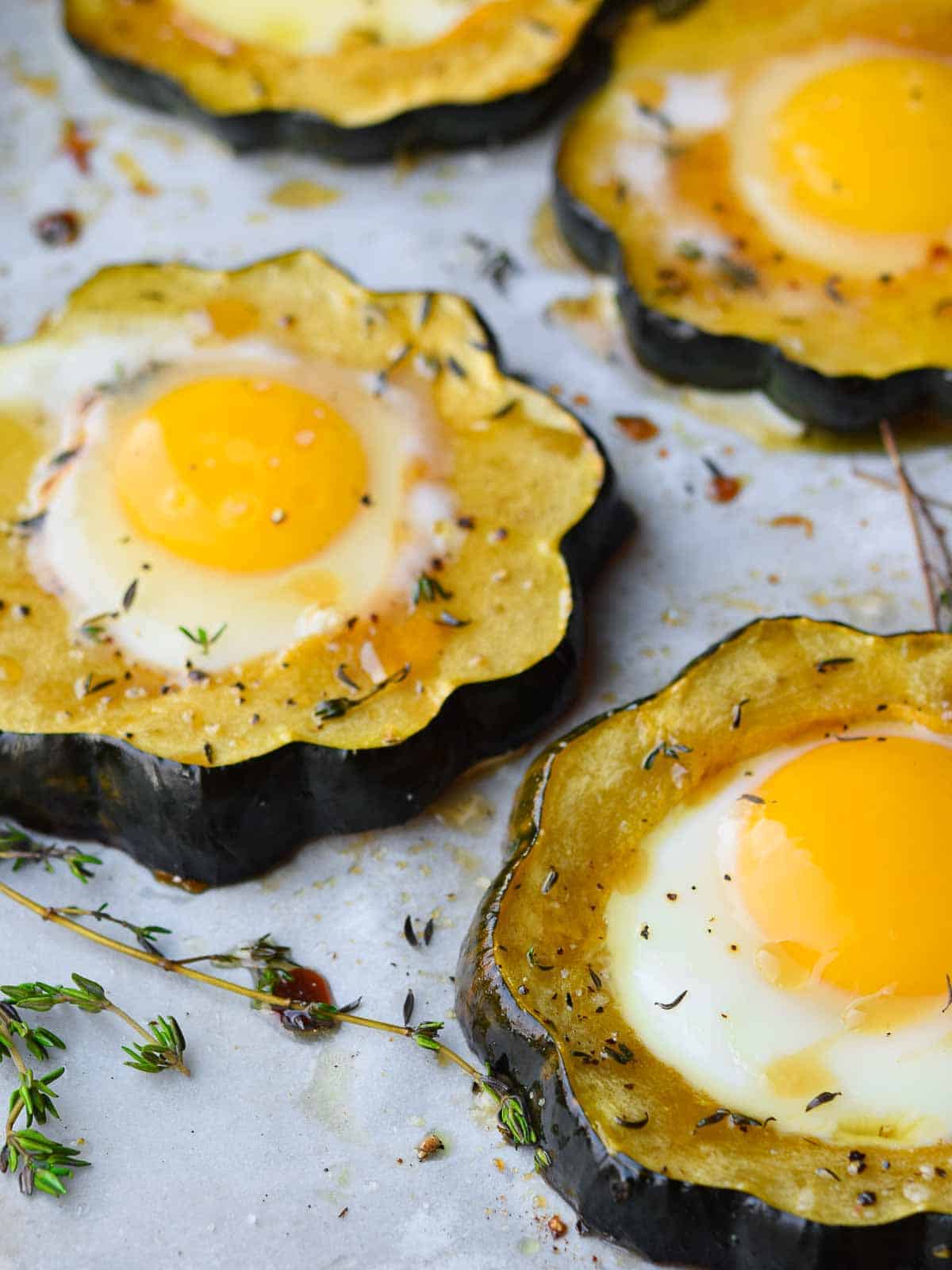
My culinary journey often finds me returning to beloved ingredients, and a deep appreciation for both squash and eggs is a constant in my kitchen. The moment I realized that a horizontally cut acorn squash resembles a delicate flower, I became obsessed with the idea of incorporating this natural beauty into a dish. This acorn squash egg in a hole is essentially a baked egg dish, but with a rustic, elegant twist. The squash isn’t just a container; it’s an integral part of the flavor and aesthetic, transforming a simple breakfast into something truly special.
To complement the inherent sweetness and nutty notes of the acorn squash, I’ve chosen simple yet impactful flavors. The hot honey isn’t just for drizzle; it caramelizes beautifully in the oven, adding a sticky, sweet-spicy glaze that perfectly enhances the squash’s natural sugars. Meanwhile, fresh thyme infuses the dish with an earthy, aromatic freshness that prevents the sweetness from becoming overwhelming and balances the richness of the egg. This combination creates a harmonious flavor profile, making it the ultimate egg dish for a festive fall brunch, a memorable Thanksgiving breakfast, or any time you crave a comforting, gourmet meal.
[feast_advanced_jump_to]
What is Acorn Squash and Why Use It?
Acorn squash is a delightful variety of winter squash, aptly named for its distinctive acorn-like shape. Its appearance is characterized by deep, ridged, dark green skin, often adorned with charming patches of orange or yellow. Beyond its eye-catching exterior, the magic truly lies within: a sweet, nutty, and subtly earthy flesh with a wonderfully smooth texture when cooked. This makes it an incredibly versatile vegetable, perfect for roasting, baking, or even stuffing.
You’ll typically find acorn squash gracing the aisles of most supermarkets and farmers markets from late September, continuing throughout the cooler winter months. It’s a quintessential fall crop, often making a grand appearance on Thanksgiving tables due to its seasonal availability and comforting flavor. Choosing acorn squash for this “egg in a hole” recipe is particularly inspired because its natural cavity, once the seeds are removed, creates a perfect, individual serving cup for an egg. Its firm flesh holds up beautifully during roasting, and its delicate skin becomes wonderfully tender and edible, adding texture and nutrients without needing to be peeled.
Beyond its culinary versatility and seasonal charm, acorn squash also offers a host of nutritional benefits. It’s a good source of fiber, which aids digestion and promotes satiety, making this breakfast dish not just delicious but also satisfying. It’s also packed with vitamins, particularly Vitamin C and several B vitamins, as well as minerals like potassium and magnesium. Incorporating acorn squash into your diet is a flavorful way to boost your nutrient intake, and this recipe highlights its natural sweetness and hearty texture in a truly unique and appealing way.
Ingredients for Your Acorn Squash Egg in a Hole
Gathering the right ingredients is the first step to creating this exceptional acorn squash egg in a hole. What’s fantastic about this recipe is its simplicity, relying on a few key ingredients that perfectly complement each other. Here’s a detailed look at what you’ll need, along with some helpful substitutions and insights:
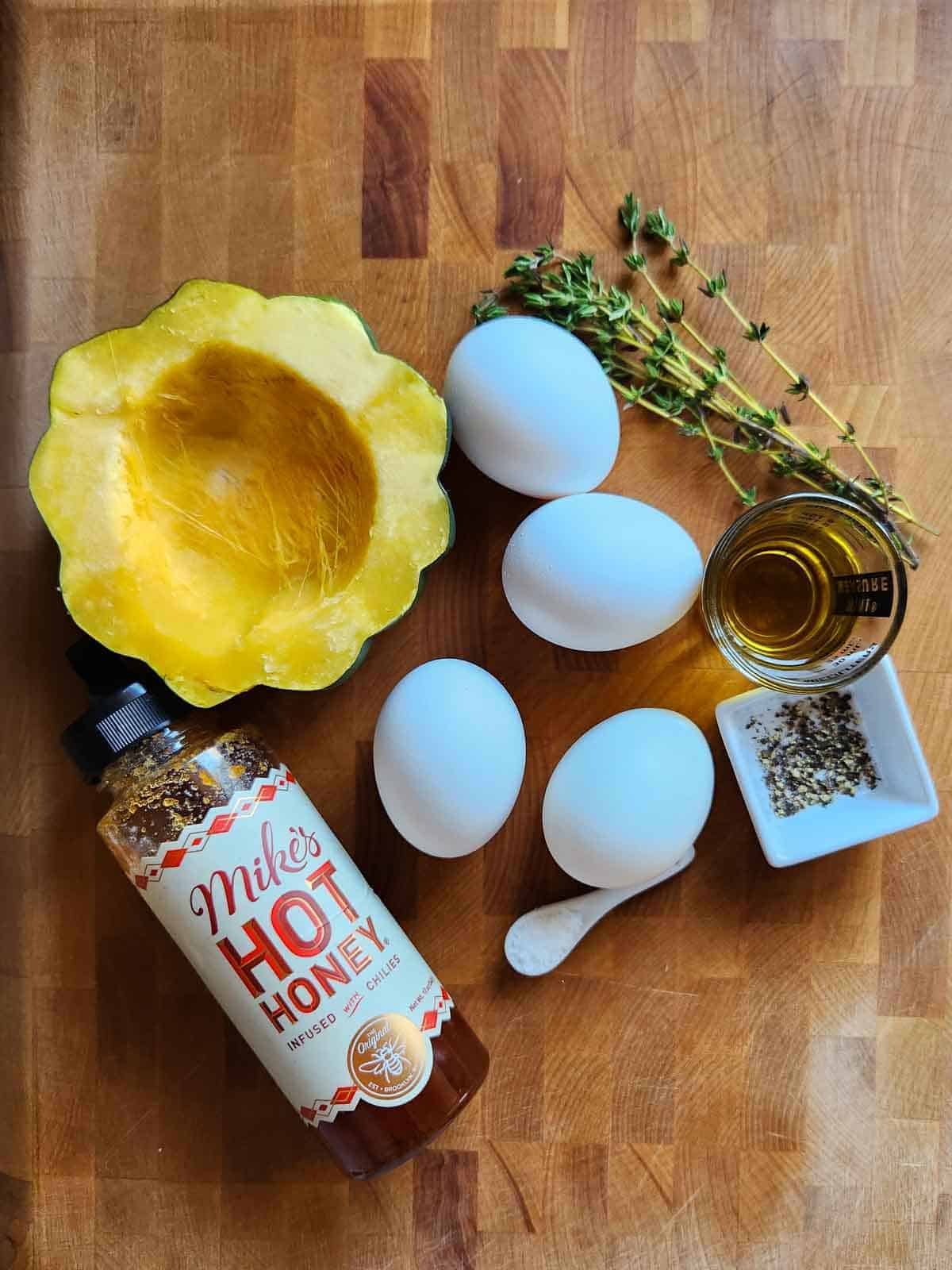
- Acorn Squash: The star of our show! Opt for smaller acorn squash, ideally around 1 to 1.5 pounds. Smaller squash tend to have more uniform “holes” for the eggs and are generally easier to handle and cut. Their size also makes for perfect individual servings.
- Eggs: You’ll need large eggs, roughly 4 to 6, depending on the number and size of the rings you get from your squash. Fresh, high-quality eggs will give you the best flavor and a beautiful, vibrant yolk.
- Olive Oil: Essential for roasting the squash. A good quality extra virgin olive oil not only helps achieve that perfectly tender texture but also adds a subtle, fruity undertone that complements the other flavors. It ensures the squash doesn’t dry out and helps the honey adhere and caramelize.
- Hot Honey: This ingredient is key to the dish’s unique sweet and spicy kick. It caramelizes in the oven, creating a delicious glaze. You can easily find hot honey in most supermarkets or specialty food stores. If you don’t have any on hand, a simple and effective substitution is to combine regular honey with a pinch of crushed red pepper flakes or a dash of your favorite hot sauce, adjusting to your preferred level of heat. The goal is to get that perfect balance of sweetness and subtle warmth.
- Thyme: Fresh thyme offers a beautiful earthy and slightly floral aroma that pairs wonderfully with both squash and honey. While fresh is always preferred for its vibrant flavor, you can certainly use dried thyme if that’s what you have. Just remember that dried herbs are more concentrated, so use about half the amount. Other fresh herbs that could work well include sage (especially for a more autumnal feel), rosemary, or even chives for a milder oniony note.
- Salt and Pepper: Kosher salt or fine sea salt, and freshly ground black pepper are essential for seasoning. They bring out and balance all the other flavors, ensuring no element is lost. Season generously to taste.
Optional Additions & Garnishes:
- Crumbled Cheese: A sprinkle of goat cheese, feta, or even grated Parmesan after baking can add an extra layer of savory tang.
- Chili Flakes/Smoked Paprika: For an extra kick or smoky depth, a dash of chili flakes or smoked paprika can be added before roasting.
- Fresh Parsley or Chives: A garnish of finely chopped fresh parsley or chives before serving can add a pop of color and herbaceous freshness.
See the recipe card below for exact quantities and detailed instructions.
Essential Equipment for This Recipe
Making this acorn squash egg in a hole is straightforward and doesn’t require any fancy gadgets. Here’s what you’ll need to ensure a smooth cooking process and easy cleanup:
- Baking Pan: A standard large baking sheet or rimmed cookie sheet is perfect for roasting the squash rings. The rims prevent any honey or oil from dripping off.
- Parchment Paper: For effortless cleanup and to prevent the squash from sticking, I highly recommend lining your baking pan with parchment paper. It also helps with even caramelization of the honey.
- Sharp Knife: Acorn squash can be quite firm, so a sturdy, sharp chef’s knife is crucial for safely and efficiently cutting it into rings. Dull knives are more dangerous and make the job much harder.
- Spoon or Ice Cream Scoop: To easily scrape out the seeds and fibrous strands from the center of the squash. An ice cream scoop works particularly well for this task.
- Small Ramekins or Bowls (Optional but Recommended): Cracking each egg into a small ramekin first before pouring it into the squash hole makes the process much tidier and allows you to easily remove any errant shell pieces.
Step-by-Step Directions: Crafting Your Acorn Squash Egg in a Hole
Follow this detailed visual guide to master these beautiful and delicious acorn squash rings with eggs. The full, printable instructions, along with exact measurements, are available on the recipe card below.
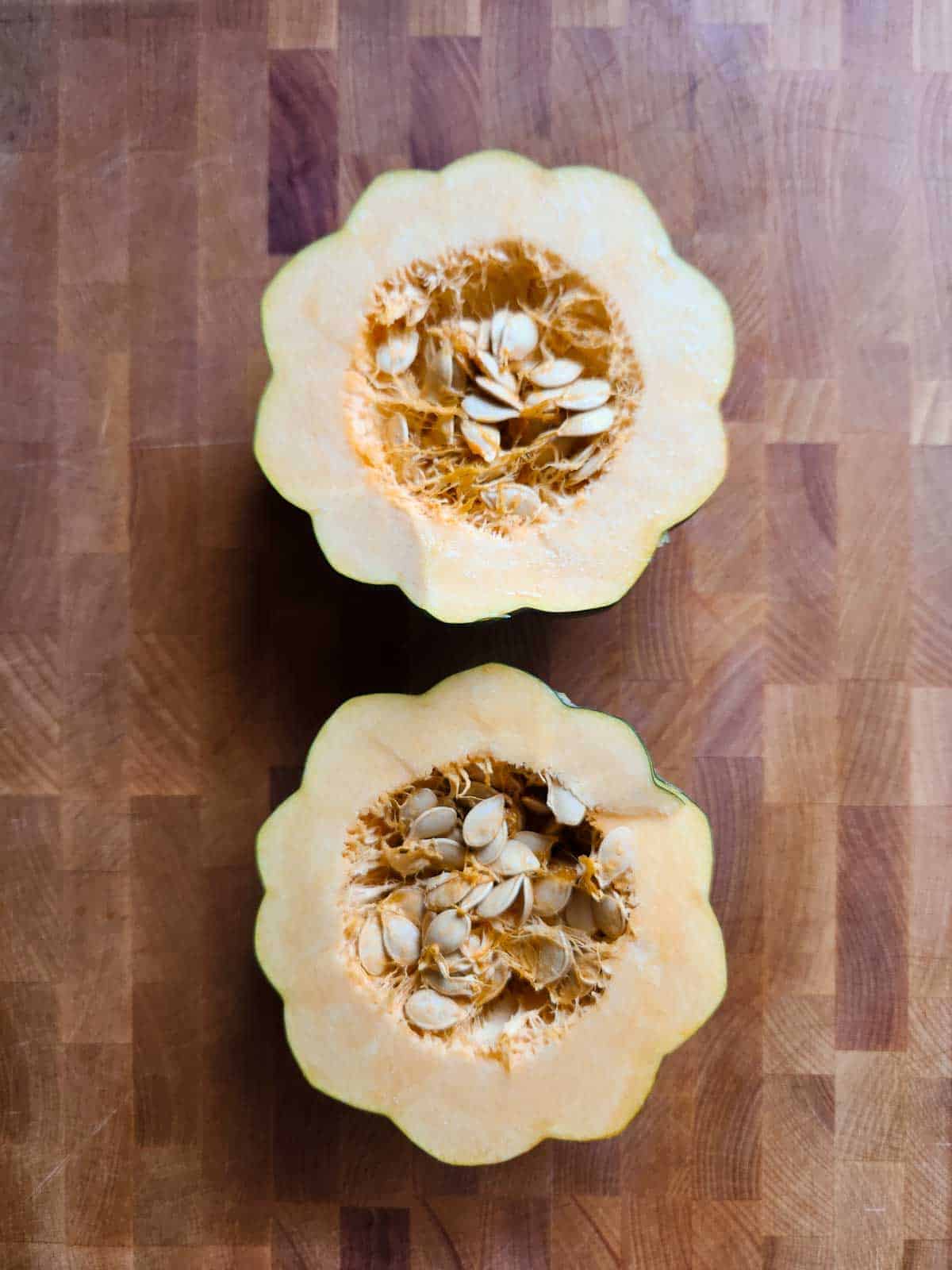
1. Prepare the Oven and Squash: Preheat your oven to a hot 425℉ (220℃). If desired, line a large baking sheet with parchment paper for easier cleanup. Carefully cut the acorn squash in half horizontally. For safety and ease, place the squash on a stable cutting board. If the squash is very hard, you can microwave it whole for 2 minutes after piercing it with a fork a few times; this will soften the skin slightly.
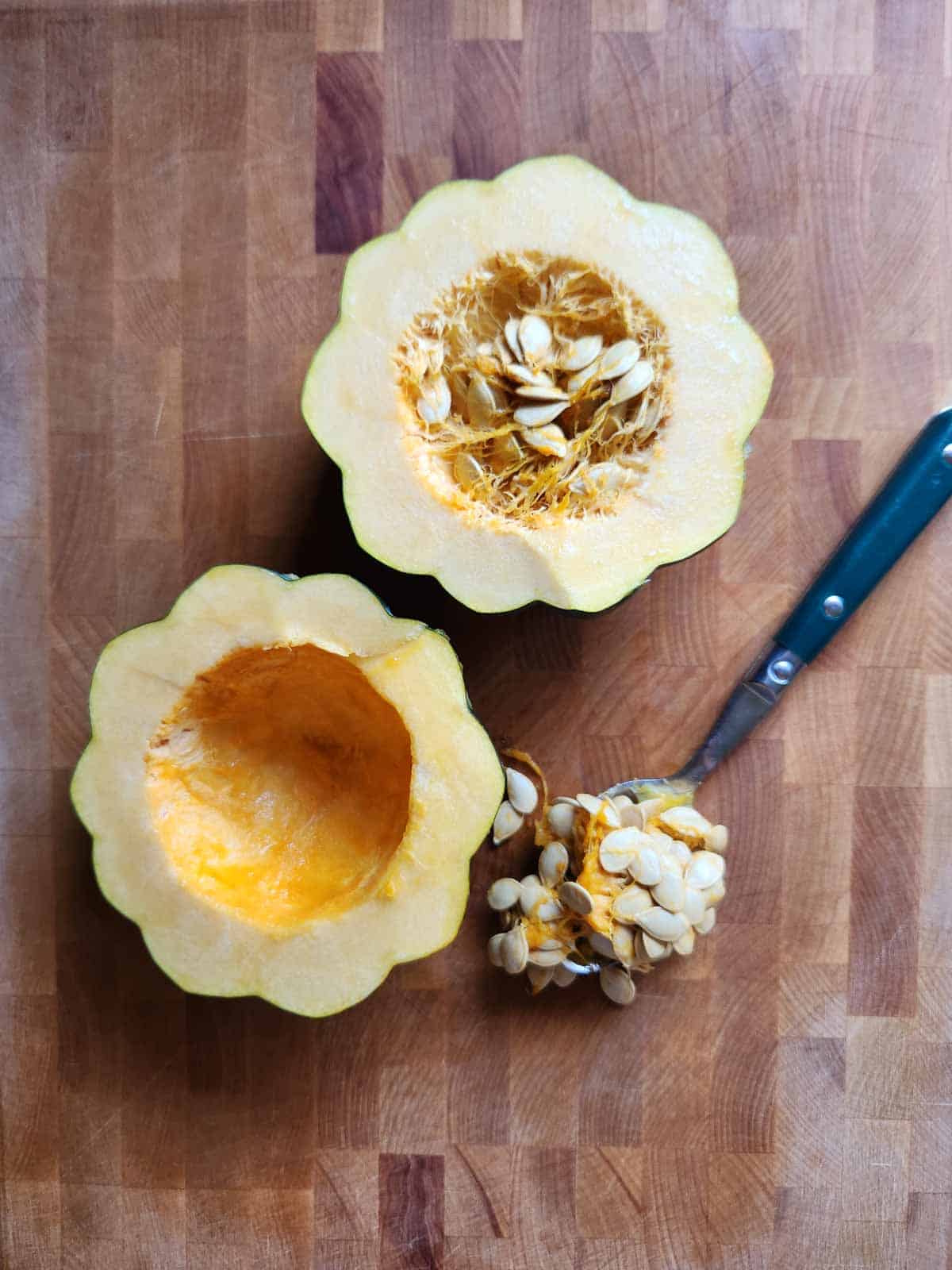
2. Scoop the Seeds: Using a sturdy spoon or an ice cream scoop, carefully scrape out all the seeds and any stringy flesh from the center of each squash half. You want to create a clean, smooth cavity that will eventually hold your egg. Don’t discard those seeds – they make a fantastic roasted snack!
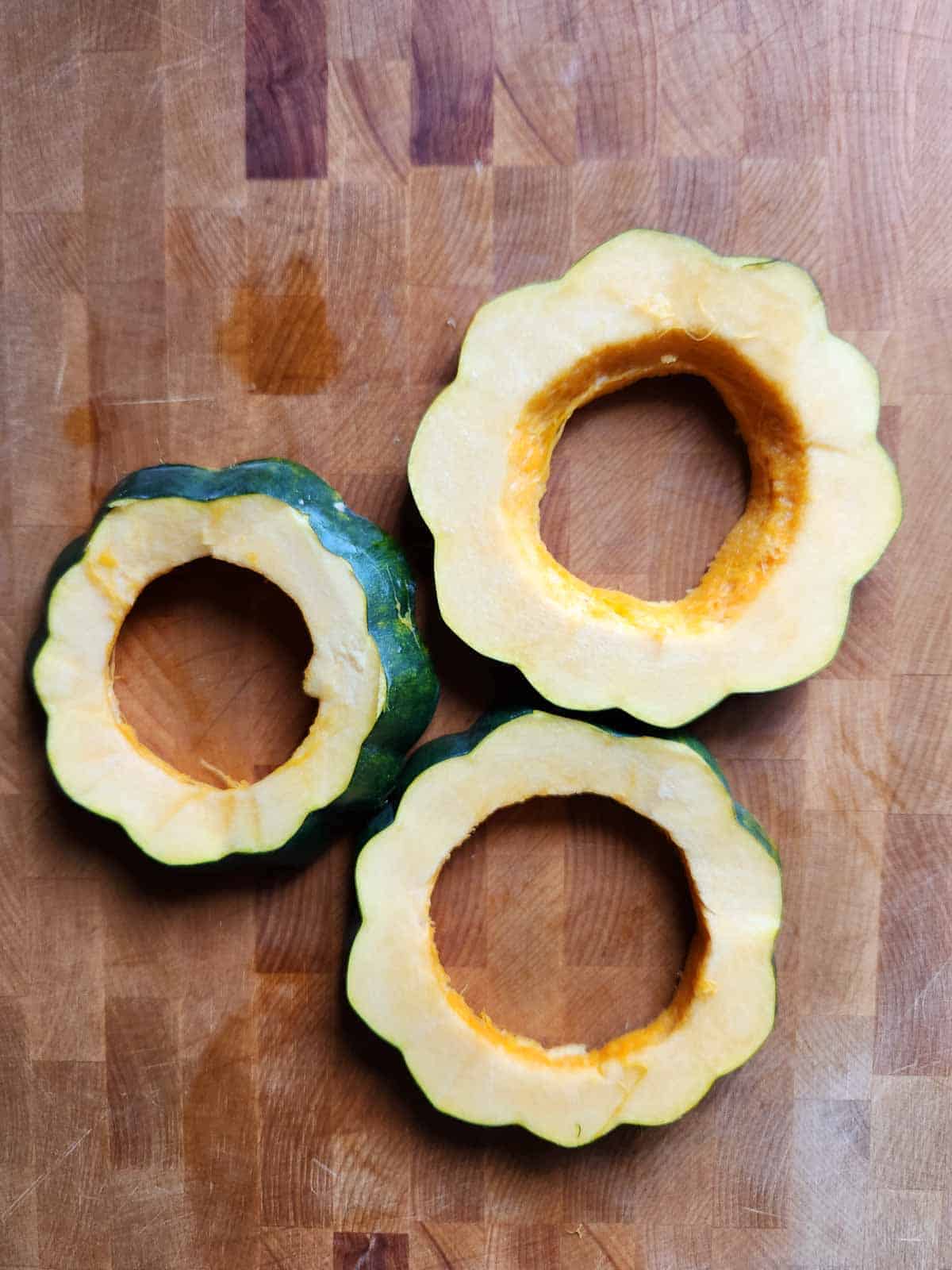
3. Slice into Rings: Place each scooped-out squash half cut-side down on your cutting board. Carefully cut each half into rings, aiming for a thickness of roughly ½ inch (about 1.25 cm). This thickness ensures even cooking and sturdy “walls” for the egg. As you get closer to the ends, the holes might become smaller; you can gently trim them with a small knife to create more uniform openings, or simply roast the smaller pieces alongside the rings for a delicious snack.
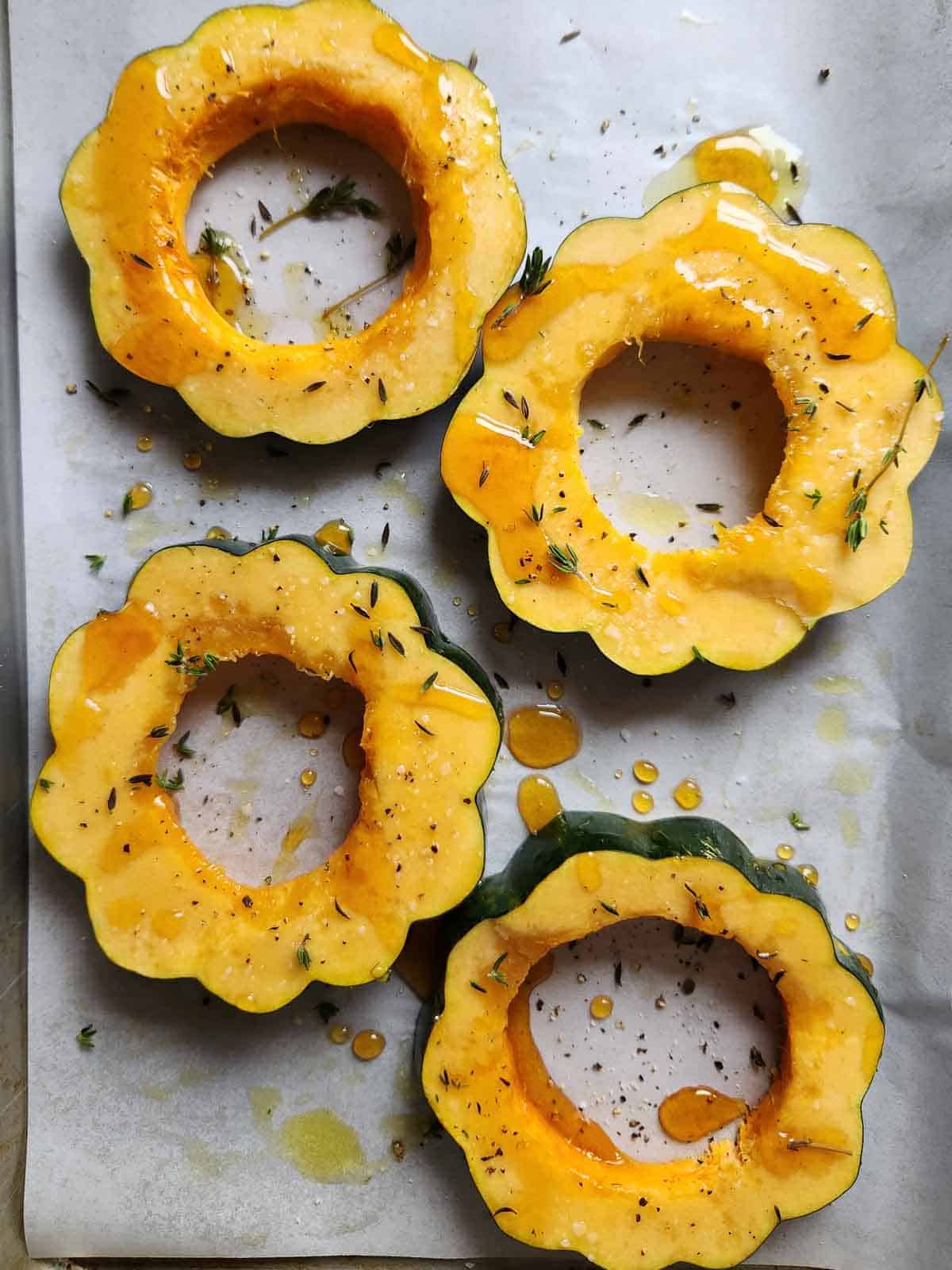
4. Season and Roast the Squash: Arrange the acorn squash rings in a single layer on your prepared baking sheet. Drizzle them generously with olive oil and then with hot honey. Sprinkle evenly with salt, pepper, and fresh thyme. Toss gently to ensure all sides are coated. Bake in the preheated 425℉ (220℃) oven for approximately 15 minutes, or until the squash is tender when pierced with a fork but still holds its shape. You want it cooked through but not mushy, as it will bake again with the eggs.
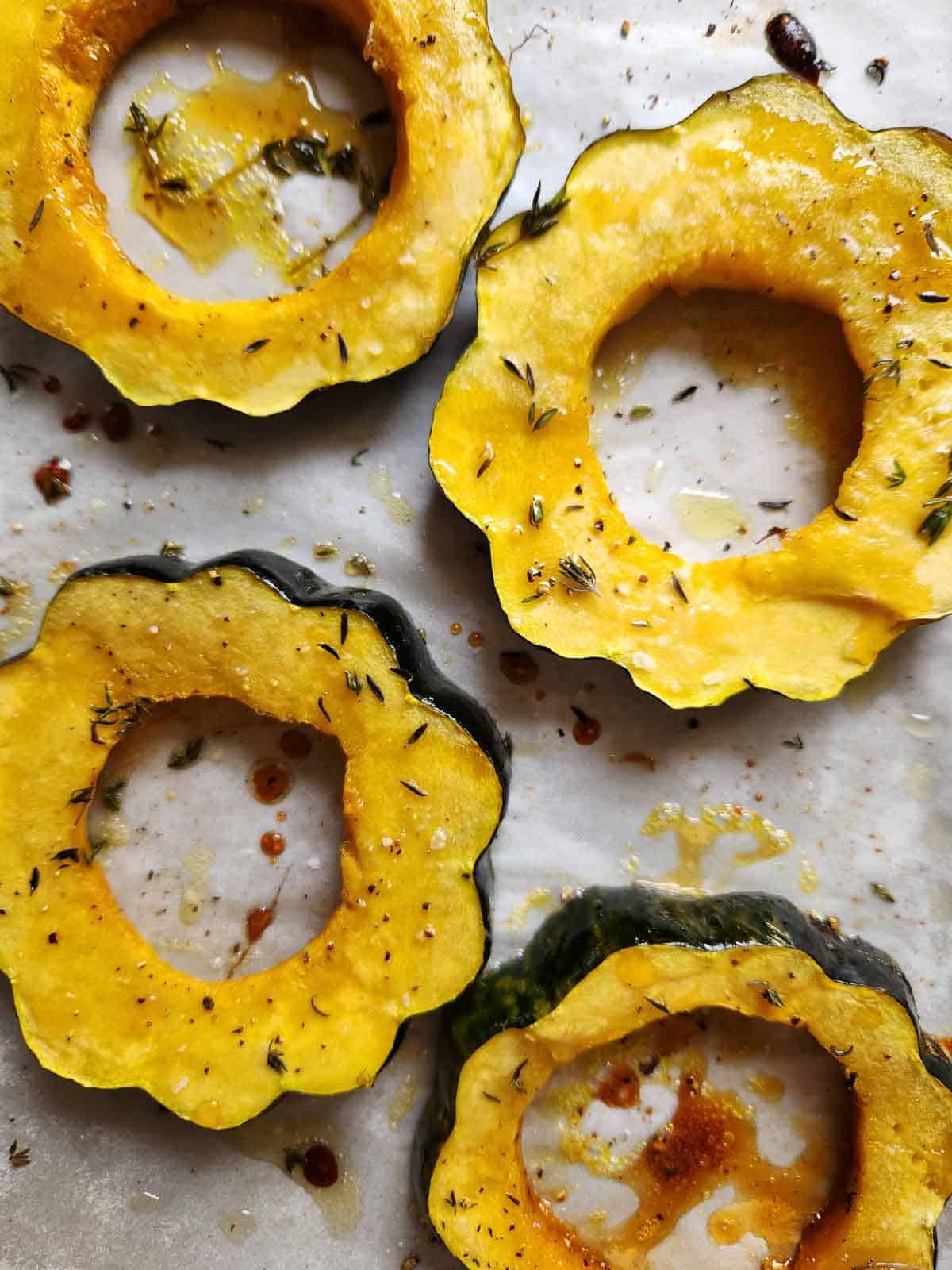
5. Lower Temperature and Prepare for Eggs: Once the squash is tender, carefully remove the baking sheet from the oven. Immediately decrease the oven temperature to 350℉ (175℃). This drop in temperature is crucial to prevent the egg yolks from overcooking and becoming rubbery.
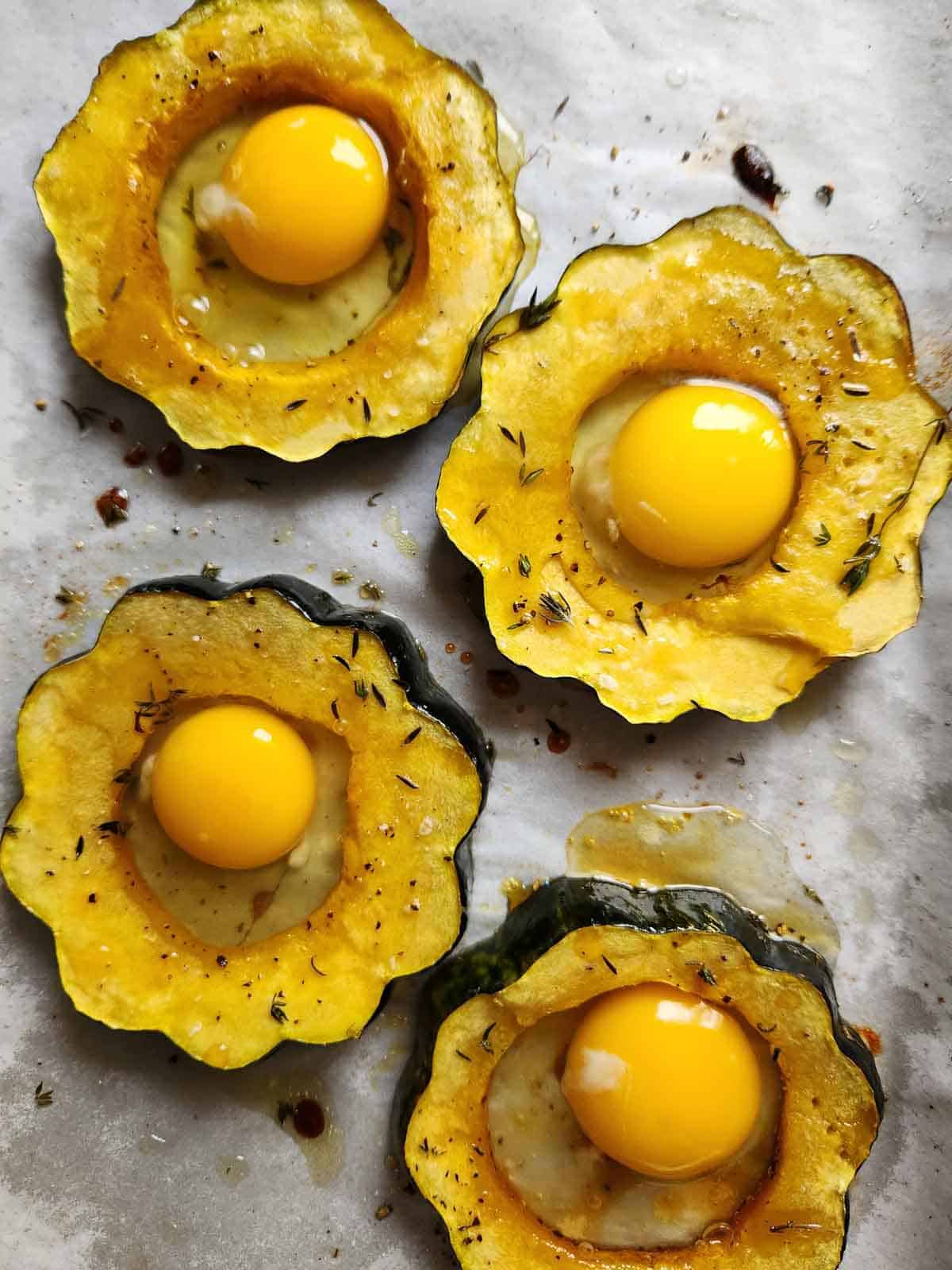
6. Add Eggs and Finish Baking: Carefully crack one egg into the center of each roasted acorn squash ring. If using ramekins, gently slide each egg into its squash vessel. Return the baking sheet to the oven and bake for an additional 8-10 minutes, or until the egg whites are set and the yolks are cooked to your preference (runnier yolks will take less time, firmer yolks will take more). Remove from the oven immediately.
Serve your beautiful acorn squash egg in a hole creations immediately. For an extra layer of flavor and moisture, drizzle with a little extra olive oil and hot honey. A final sprinkle of salt, pepper, and fresh thyme will elevate the presentation and taste. Enjoy!
👩🍳 Expert Tips for Perfect Acorn Squash Eggs
- Uniform Ring Size is Key: For consistent cooking and optimal presentation, aim to cut your acorn squash rings to an approximate ½ inch (1.25 cm) thickness. This ensures they become tender without falling apart and cook evenly.
- Optimize Your Egg Cavities: The holes in your squash rings should ideally be about 2-2.5 inches (5-6.5 cm) in diameter to perfectly hold a large egg. Don’t hesitate to trim the holes slightly with a small paring knife to make them more uniform if needed.
- The Ramekin Trick for Eggs: To make adding the eggs to the squash rings much cleaner and easier, crack each egg into a small ramekin or bowl first. This not only allows you to check for any shell fragments but also gives you more control when gently gliding the egg into the squash hole.
- Mastering Your Yolk: If you prefer a beautifully runny yolk, start checking for doneness around the 8-minute mark during the second bake. For firmer, more well-done eggs, extend the baking time by a couple of minutes, checking frequently.
- Temperature Control is Crucial: Remember to lower your oven temperature from 425℉ to 350℉ before adding the eggs. Baking eggs at too high a temperature can cause the yolks to cook too quickly and become rubbery, losing that desirable creamy texture.
- Combatting Oven Hot Spots: If you know your oven tends to have hot spots, rotate your baking pan halfway through both the initial squash roasting and the final egg baking process. This helps ensure even cooking across all your squash rings.
- Utilize Leftover Squash Pieces: Don’t let any smaller pieces of squash go to waste! If some slices aren’t quite big enough to hold an egg, roast them alongside the rings. These tender, flavorful pieces are excellent additions to frittatas, salads, or simply enjoyed as a side dish.
- Don’t Toss the Seeds! Acorn squash seeds are surprisingly delicious when roasted. Clean them, toss them with a little olive oil, salt, and your favorite seasonings (like paprika, garlic powder, or chili powder), and roast them until golden and crispy for a healthy, crunchy snack.
Delightful Serving Suggestions
This Acorn Squash Egg in a Hole is a versatile dish that can be enjoyed on its own or paired with a variety of complementary items to create a complete and satisfying meal. Here are some of my favorite ways to serve it:
- Classic Toast Companion: A thick slice of your favorite toasted bread – sourdough, whole wheat, or even a crusty artisan loaf – is the perfect partner. It’s ideal for soaking up that wonderfully drippy egg yolk and the sweet-spicy honey glaze from the squash.
- Fresh Fruit Medley: Keep it light and refreshing by serving alongside a colorful cup of seasonal fresh fruit. Berries, sliced apples, pears, or a vibrant citrus salad would offer a lovely contrast to the savory sweetness of the squash and egg.
- Crispy Bacon Bliss: While this recipe is vegetarian, adding a side of perfectly cooked crispy bacon (or even a few strips of savory turkey bacon) elevates it to a truly indulgent breakfast. The salty crunch of bacon provides a fantastic counterpoint to the tender squash and creamy egg.
- Simple Side Salad: For a lighter, more brunch-appropriate meal, pair your squash eggs with a fresh green side salad. A simple vinaigrette dressing will complement the flavors without overpowering them. Consider a mix of delicate greens like arugula or spinach for a peppery bite.
- Hearty Oatmeal Harmony: Whether you prefer your oatmeal warm and comforting or as a refreshing overnight oats preparation, a bowl of oatmeal makes for a well-rounded meal. The fiber and complex carbohydrates will keep you feeling full and energized.
- Holiday Brunch Centerpiece: With its beautiful presentation and seasonal ingredients, this dish is absolutely perfect for a festive holiday brunch spread. Imagine it gracing your Thanksgiving or Christmas breakfast table, alongside other fall favorites like a moist cranberry gingerbread loaf or fluffy Belgian-style pumpkin spice waffles. It adds a touch of elegance and seasonal charm.
- Aromatic Coffee or Tea: A freshly brewed cup of coffee, a warm chai latte, or a fragrant herbal tea would be an excellent beverage pairing to start your day with this delightful dish.
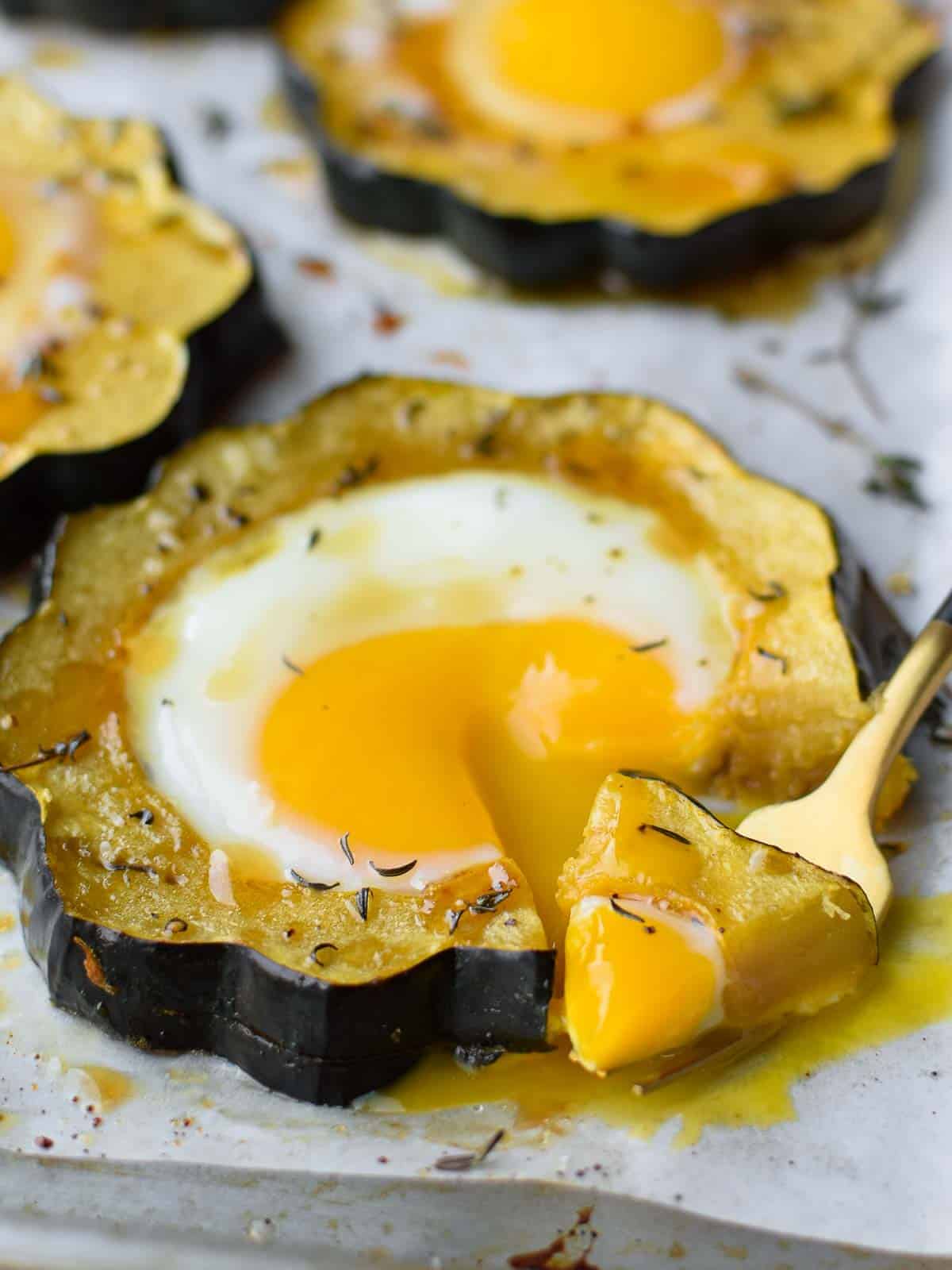
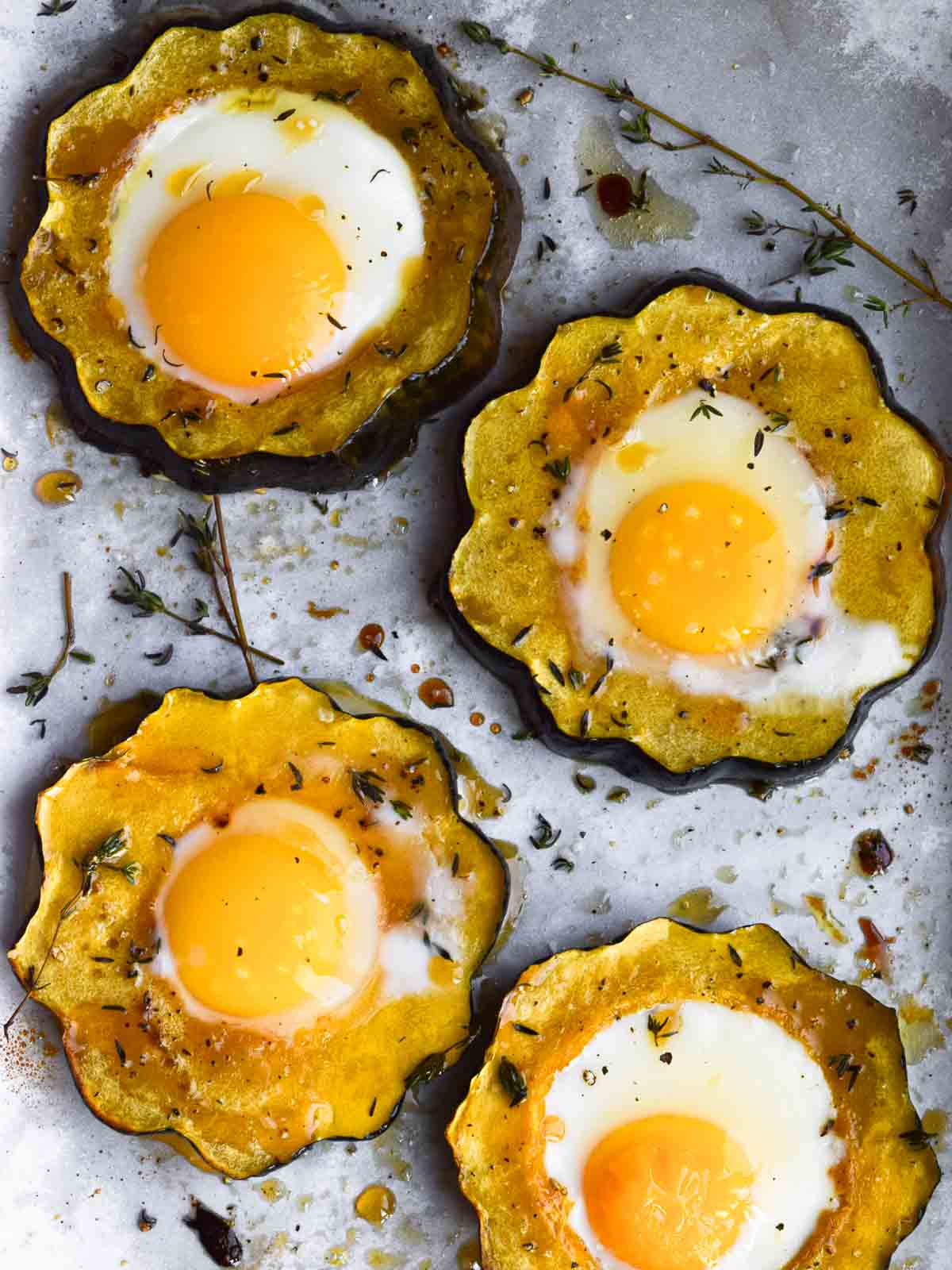
Storage and Make-Ahead Tips
This acorn squash egg in a hole is best enjoyed fresh, but thoughtful preparation and storage can make it a convenient option for busy mornings or meal prepping:
- Make-Ahead Squash Rings: You can roast the acorn squash rings in advance without the eggs. Once they are tender, allow them to cool completely. Store them in an airtight container in the refrigerator for up to four days. When you’re ready to enjoy them, simply remove the rings from the refrigerator, arrange them on a baking sheet, and proceed with adding and cooking the eggs as per the recipe instructions. This significantly cuts down on prep time on the day you plan to serve.
- Storing Cooked Rings with Eggs: If you have leftovers where the eggs are already cooked, you can store the acorn squash egg rings in an airtight container in the refrigerator for up to two days. Keep in mind that the egg yolk will continue to cook and firm up during storage.
- Reheating Instructions: To reheat, you have a few options. You can quickly pan-fry them over medium-low heat until warmed through, which can also help crisp up the squash edges. Alternatively, gently reheat them in the microwave for 30-60 seconds per piece. Be aware that when reheating, the egg will continue to cook and may become a little drier than when freshly made. However, they are still perfectly edible and delicious!
- Reviving Reheated Eggs: As mentioned, the egg yolks may lose some of their runny appeal upon reheating. To “revive” them and add back some moisture and flavor, I recommend drizzling a little extra olive oil and a fresh swirl of hot honey over the top just before serving. A sprinkle of fresh salt and pepper can also work wonders.
Frequently Asked Questions (FAQ)
Yes, absolutely! Acorn squash has a relatively delicate skin that softens beautifully when roasted. Not only is it perfectly edible, but it also contains additional fiber and nutrients. To ensure the skin cooks down to a tender texture, make sure your acorn rings are cut uniformly, approximately ½ inch thick, during the initial preparation.
Cutting a raw acorn squash can be challenging due to its hard skin. For an easier and safer cut, first pierce the whole squash several times with a fork. Then, microwave the squash for 2-3 minutes. This brief microwave time will slightly soften the skin, making it much easier and safer to cut. Once cooled enough to handle, place it on a stable cutting board, cut it in half horizontally with a sharp knife, scoop out the seeds, and then slice each half into rings.
While acorn squash is ideal due to its natural “hole” shape and excellent flavor profile, you could experiment with other winter squashes like delicate squash or even butternut squash. If using butternut squash, you would need to peel it and then cut thick rounds, possibly using a round cookie cutter to create the “hole” for the egg, as its center isn’t naturally hollow. The cooking times may also vary slightly.
No problem at all! You can easily make your own by combining regular honey with a pinch of crushed red pepper flakes, or a dash of your favorite hot sauce. Start with a small amount and taste to adjust the heat to your preference. This homemade version works just as well to achieve that sweet and spicy balance.
Yes, this acorn squash egg in a hole recipe is naturally gluten-free and dairy-free, making it suitable for those with dietary restrictions or preferences. It relies on whole, unprocessed ingredients. If you add any optional toppings, always double-check their ingredients.
Favorite Pairings to Enhance Your Meal
These are some of my go-to recipes that perfectly complement a delicious egg dish like our Acorn Squash Egg in a Hole, rounding out your breakfast or brunch spread beautifully:
- Blended Cottage Cheese Breakfast Bowls
- Lemon Ricotta Raspberry Toast
- Pecan Pie Baked Oatmeal
- Leftover Buttermilk French Toast
Did you make this delightful recipe? We would love to hear all about your experience! Please leave a ⭐⭐⭐⭐⭐ rating with a comment right below the recipe card. If you capture a photo of your magnificent creation, don’t forget to tag me on Instagram @brunchandbatter. Your feedback and photos inspire us!
📖 Recipe Card

Acorn Squash Egg in a Hole with Hot Honey and Thyme
Prevent your screen from going dark
Pin Recipe
5 minutes
25 minutes
30 minutes
Breakfast, Lunch, Side Dish
American
2
(or 3, depending on size of squash)
255
kcal
Equipment
-
baking sheet (parchment paper optional)
-
sharp knife
-
Spoon or ice cream scoop
-
Small ramekins (optional, for cracking eggs)
Ingredients
- 1 small acorn squash (a little over 1lb, choose small for best rings)
- 1 tablespoon olive oil (extra virgin recommended)
- 1-2 tablespoon hot honey (or regular honey with a pinch of red pepper flakes)
- 1-2 teaspoon fresh thyme (finely chopped, or ½-1 tsp dried thyme)
- ¼ Kosher or fine sea salt
- ⅛ freshly ground pepper
- 4-6 large eggs (will depend on the number of squash rings you get after cutting)
Instructions
-
1. Preheat and Prepare: Preheat your oven to 425℉ (220℃). If desired, line a large baking sheet with parchment paper for non-stick baking and easier cleanup.
-
2. Prepare the Squash: Carefully cut the acorn squash in half, horizontally. Using a spoon or ice cream scoop, thoroughly scrape out the seeds and any stringy flesh from the center. Then, cut each half into rings, aiming for approximately ½ inch (1.25 cm) thick. You should yield about 4-6 rings depending on the size of your squash. As you cut towards the ends, you may need to trim the holes slightly to make them more uniform for the eggs.1 small acorn squash
-
3. Season and First Bake: Arrange the squash rings in a single layer on the baking sheet. Drizzle evenly with olive oil and hot honey, then season generously with salt, pepper, and fresh thyme. Bake for 15 minutes, or until the squash is tender when gently pierced with a fork but still firm enough to hold its shape.1 tablespoon olive oil,
1-2 tablespoon hot honey,
1-2 teaspoon fresh thyme,
¼ Kosher or fine sea salt,
⅛ freshly ground pepper -
4. Add Eggs and Final Bake: Remove the squash from the oven and immediately lower the oven temperature to 350℉ (175℃). Carefully crack one egg into the center of each squash ring. Return the baking sheet to the oven and bake for an additional 8-10 minutes, or until the egg whites are fully set and the yolks are cooked to your desired consistency (shorter time for runny yolks, longer for firm). Remove from the oven.4-6 large eggs
-
5. Serve: Serve immediately. For enhanced flavor and presentation, drizzle with a little extra olive oil and hot honey, and season to taste with additional salt, pepper, and fresh thyme if desired. Enjoy your beautiful and delicious acorn squash egg in a hole!
Notes
- Try to keep the acorn rings the same size (approximately ½ inch thick yields the best results for even cooking and presentation).
- Your squash holes should be about 2-2.5 inches in diameter. You can trim the holes slightly to keep them more uniform for the eggs.
- To make adding the egg easier to the holes and to check for shells, crack each egg into a small ramekin first, then gently glide the egg into the hole.
- If you like your yolks runny, start checking for doneness at around the 8-minute mark during the second bake. Cook longer if you prefer your eggs well done.
- If you forget to lower your oven heat before adding eggs, the egg yolk will cook too fast and might become rubbery. Temperature control is key!
- If your oven has hot spots, try rotating your pan halfway through both cooking processes to ensure even roasting and baking.
- If you have leftover pieces of squash that aren’t quite big enough for an egg, simply roast them along with the rings. These extra pieces are delicious tossed into frittatas, salads, or as a simple snack.
- Don’t toss the seeds! Clean and roast them with some olive oil and your favorite seasonings (salt, pepper, paprika) for a healthy and crunchy snack.
Nutrition*
Serving:
2
squash
Calories:
255
kcal
Carbohydrates:
34.3
g
Protein:
5.1
g
Fat:
12.8
g
Saturated Fat:
2.5
g
Cholesterol:
124
mg
Sodium:
600
mg
Potassium:
238
mg
Fiber:
1.9
g
Sugar:
27.8
g
Calcium:
65
mg
Iron:
3
mg
*Nutrition information is provided as a courtesy and is an estimate only. Nutrition information can vary depending on many factors, such as products used, measurements and substitutions, therefore it is recommended that you obtain nutritional calculations based on your own finished recipe.
Have you tried this recipe?
Leave a comment below and share a photo on Instagram. Tag @brunchandbatter or hashtag it with #brunchandbatter
